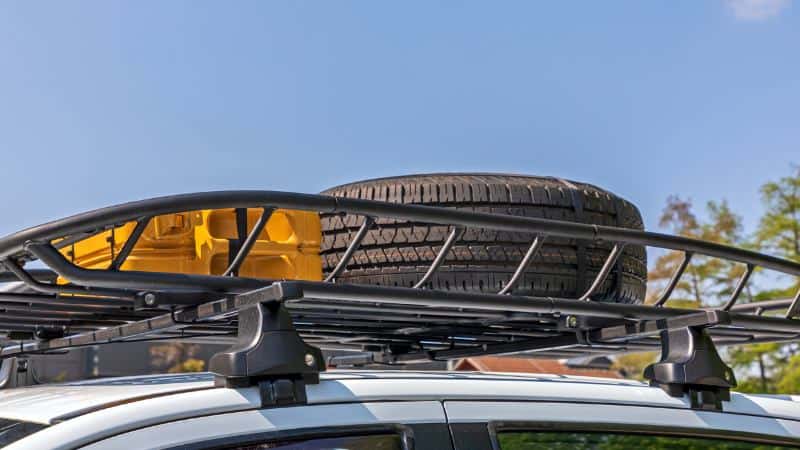Toyota RAV4 Roof Rack Weight Limit: Balance Safety & Utility
The Toyota RAV4 roof rack weight limit is a vital piece of information for adventure enthusiasts and travelers who rely on their trusty RAV4 for countless journeys. As you prepare for your next escapade, you may wonder, “How much weight can a RAV4 rooftop hold?“
The RAV4 rooftop can carry or hold up to 176.4 lbs. (80kg) of distributed weight. Older RAV4 models’ roof weight limit ranges from 100 lbs. up to 150 lbs. (see a chart by generation or year below).
In this comprehensive guide, we will cover the weight limit of the RAV4 roof rack, the dangers of overloading the roof rack, and the factors that influence the weight limits. We will also share some important safety tips to help you get the most out of your RAV4’s roof rack without putting anyone in harm’s way.
Are you interested in freeing up some cargo space in your RAV4? See the 5 best RAV4 roof rack and cross bars.
- Roof Rack Weight Limits By Generation
- What Affects RAV4’s Roof Rack Weight Limits?
- Properly Loading Your Roof Rack
- Safety Tips for RAV4 Roof Rack Use
- RAV4 Factory Installed Roof Racks vs. Aftermarket Roof Racks
- Toyota RAV4’s Popularity and Versatility for Adventure Seekers
- Frequently Asked Questions (FAQs)
Roof Rack Weight Limits By Generation
Weight limits for RAV4 roof racks can vary by generation and the type of roof rack system installed.
Here’s a brief overview of manufacturer specifications for each generation:
| RAV4 Generation | RAV4 Years | Roof Rack Weight Limit |
|---|---|---|
| 1st | 1994-2000 | 100 lbs. (45kg) |
| 2nd | 2001-2005 | 100 lbs. (45kg) |
| 3rd | 2006-2012 | 102.7 lbs. (46.2kg) |
| 4th | 2013-2018 | 150 lbs. (68kg) |
| 5th | 2019-2023 | 176.4 lbs. (80kg) |
Weight limits for RAV4 roof racks differ by generation and type of rack system. Always check your vehicle’s specifications and aftermarket rack guidelines for accurate information.
Aftermarket Roof Racks Weight Limits
For aftermarket roof rack systems, weight limits vary by brand and design. Consult the manufacturer’s guidelines for accurate weight capacity information. Keep in mind that aftermarket racks should always be compatible with your RAV4’s model and generation to ensure safety and optimal performance.
Are you interested in mods and accessory ideas for your RAV4? See the 45 best Toyota RAV4 mods & aftermarket accessories.
What Affects RAV4’s Roof Rack Weight Limits?
There are a few different factors that can affect the roof rack weight limit such as, roof capacity, roof rack material and design, load distribution and aerodynamics, and accessories and attachments.
Roof Capacity
Vehicle roof capacity is the maximum weight your RAV4’s roof can safely support. It’s a crucial factor to consider when determining the weight limit of your roof rack system.
The roof capacity is determined by the vehicle’s design, structural integrity, and materials used in construction. Exceeding the roof capacity can lead to damage, compromised safety, and decreased vehicle performance.
When selecting a roof rack system, always ensure that its weight limit, along with the weight of your cargo, does not surpass your RAV4’s roof capacity. Consult your vehicle owner’s manual for specific roof capacity information.
Want to know how much cargo space the RAV4 has? See a detailed breakdown of the RAV4 cargo space and dimensions with photos.
Understanding your RAV4’s roof capacity is essential for choosing a roof rack system with a suitable weight limit, ensuring safe and efficient use.

Roof Rack Material and Design
The material and design of a roof rack can significantly affect its weight limit, as different materials and structures have varying strength and load-bearing capabilities.
Common materials used in roof racks include aluminum, steel, and plastic. Aluminum racks are lightweight and corrosion-resistant, making them popular choices. However, they may have a lower weight capacity compared to steel racks, which are heavier and stronger but more susceptible to corrosion. Plastic racks, while lighter and more affordable, generally have the lowest weight limits.
The design of a roof rack also plays a crucial role. Crossbar shape, mounting systems, and overall construction can impact weight distribution and stability. More robust designs often have higher weight limits but may also increase wind resistance and fuel consumption.
When choosing a rack, consider the trade-offs between weight capacity, durability, and fuel efficiency. Always ensure compatibility with your RAV4 for safe and effective use.
Curious about your RAV4’s fuel efficiency? We’ve got you covered!
- Want the numbers? Check out our RAV4 MPG calculator for city, highway, and combined mileage for any year and trim.
- Looking for real-world insights? See real-world RAV4 gas mileage data from fellow RAV4 owners and how far your RAV4 can take you on a full tank of gas.
- Ready to estimate your weekly gas costs? Dive into our Toyota RAV4 Fuel Consumption Calculator: Estimate Gas Costs and take control of your fuel budget!
Load Distribution and Aerodynamics
Load distribution and aerodynamics significantly impact the weight limit of a roof rack, as they influence overall stability and safety while driving.
Proper load distribution is essential to avoid exceeding the weight capacity of any specific area of the rack. Evenly distributing the load across the entire roof rack ensures that weight is well-supported and reduces strain on the vehicle’s roof. Imbalanced loads can negatively affect handling and stability, increasing the risk of accidents.
Aerodynamics also plays a vital role in roof rack use. Bulky or poorly positioned cargo can create drag, resulting in decreased fuel efficiency and increased wind noise. Selecting a roof rack with a streamlined design and carefully arranging your cargo to minimize wind resistance can help mitigate these issues.
Proper load distribution and attention to aerodynamics can optimize your roof rack’s weight capacity and ensure safe, efficient use. Always adhere to manufacturer guidelines when loading and positioning cargo on your RAV4’s roof rack.
Accessories and Attachments
When using accessories like bike racks, kayak mounts, or cargo boxes, remember that their weight counts toward the total weight limit of the roof rack system. Always account for their weight when calculating the remaining capacity for your cargo.

Additionally, attachments may alter the load distribution and aerodynamics of your roof rack setup. Make sure to follow manufacturer guidelines when installing and using accessories to ensure proper balance, minimal wind resistance, and safe operation.
Adhering to manufacturer recommendations will help maintain safety and efficiency while utilizing your rack to its full potential.
Is the RAV4 a good car? See this in-depth review on whether or not the RAV4 is an all-around good car.
Properly Loading Your Roof Rack
Loading your RAV4 roof rack correctly is very important to ensuring safety, stability, and efficient use of its cargo-carrying capacity. When loading your roof rack it is important to remember some key aspects of loading your roof rack such as, understanding load capacity, securely fastening items, and inspecting the roof rack system. Let’s dive in to guarantee you make the most of your RAV4’s roof rack while keeping you and your cargo safe on the road.
Understanding Load Capacity and Balance
Load capacity is the maximum weight your roof rack can safely carry, and balance refers to the even distribution of this weight. Understanding these concepts is vital for safe roof rack usage.
- Load capacity: Check your RAV4 owner’s manual or roof rack manufacturer’s guidelines for weight limits. Never exceed this capacity to ensure safety and vehicle stability.
- Balance: Distribute weight evenly across the roof rack, placing heavier items closer to the center. Proper balance improves handling and reduces strain on your RAV4’s roof.
By being mindful of load capacity and balance, you’ll optimize the performance of your RAV4’s roof rack system while keeping yourself and others safe on the road.
Can a Toyota RAV4 go off-roading? See a comprehensive Toyota RAV4 Off-Roading guide and Review.
Securely Fastening and Tying Down Items
Ensuring your cargo is securely fastened and tied down is crucial for safe transportation on your RAV4’s roof rack. Follow these tips for a secure load:
- Use high-quality straps or bungee cords to tie down items, ensuring they’re in good condition and free of damage.
- For oddly-shaped or bulky cargo, consider using a cargo net or specialized mounts designed for specific items, such as bikes or kayaks.
- Always double-check that straps are tight and cargo is secure, with no movement or shifting when gently tugged.
- Periodically inspect the cargo during your journey, especially after driving on bumpy roads or making sudden stops.
By fastening and tying down items securely, you’ll reduce the risk of accidents and ensure safe transportation of your cargo on your RAV4’s roof rack.
Regularly Inspecting the Roof Rack System
Regular inspection of your RAV4’s roof rack system helps maintain its safety and functionality. Here are a few tips for routine checks:
- Before each use, examine the roof rack for signs of wear, corrosion, or damage. Replace any damaged components as needed.
- Ensure all mounting points and connections are secure and tight, with no signs of loosening or instability.
- Check straps, bungee cords, and other fastening accessories for wear or damage. Replace them if necessary to guarantee safe cargo transportation.
- Periodically inspect the roof rack during long trips, ensuring the system remains secure and the cargo stays firmly in place.
By regularly inspecting your roof rack system, you’ll prolong its lifespan and ensure safe use for every adventure with your RAV4.

Safety Tips for RAV4 Roof Rack Use
When using a roof rack it is important to remember to adhere to the manufacturer’s guidelines. Regularly check and maintain the roof rack and plan trips with the roof load in mind.
Adhering to Manufacturer’s Guidelines
Adhering to the manufacturer’s guidelines when using a roof rack is essential for several reasons:
- Safety: Manufacturer guidelines are designed to ensure the safe use of roof racks, taking into account the vehicle’s structural capabilities, load distribution, and stability. Following these guidelines minimizes the risk of accidents and damage to your vehicle.
- Vehicle Performance: Exceeding weight limits or improperly distributing cargo can negatively impact your vehicle’s handling, braking, and fuel efficiency. Adhering to guidelines helps maintain optimal performance and a smoother driving experience.
- Warranty and Insurance: Not following the manufacturer’s guidelines could void your vehicle or roof rack warranty and may impact insurance claims in case of accidents or damage.
- Legal Compliance: Some jurisdictions have regulations governing the use of roof racks, including weight limits and cargo dimensions. Following manufacturer guidelines ensures compliance with these rules.
Regularly Checking and Maintaining the Roof Rack System
The importance of regularly checking and maintaining the roof rack system lies in the following factors:
- Safety: Regular inspections help detect signs of wear, damage, or loosening components, allowing you to address these issues before they compromise the safety of your passengers, vehicle, and cargo.
- Reliability: Regular maintenance prolongs the lifespan of your roof rack system, ensuring it remains in optimal working condition for your adventures.
- Performance: A well-maintained roof rack system functions more efficiently, providing better stability and minimizing issues like wind noise or fuel consumption increases.
- Cost Savings: By addressing potential issues early, you can avoid costly repairs or replacement of the roof rack components, saving you money in the long run.
- Peace of Mind: Regularly checking and maintaining your roof rack system gives you confidence that it is functioning safely and efficiently, allowing you to focus on enjoying your adventures without worrying about potential problems.
Planning Trips with Roof Load in Mind
Planning trips with roof load in mind when using a roof rack is important for several reasons:
- Safety: Considering the roof load helps ensure you don’t exceed the weight limit of your roof rack system, preventing accidents or damage to your vehicle, passengers, and cargo.
- Vehicle Performance: By planning with the roof load in mind, you can maintain optimal vehicle handling, braking, and fuel efficiency, as an overloaded or improperly balanced roof rack can negatively impact these aspects.
- Route Planning: Knowing your roof load allows you to choose suitable routes, avoiding low-clearance bridges, tunnels, or overpasses that might pose a hazard to your cargo or vehicle.
- Cargo Protection: Planning ahead helps you select the appropriate cargo carriers or attachments for your roof rack, ensuring your items are securely fastened and protected from damage during transit.
- Time and Cost Efficiency: Being aware of your roof load can help you avoid potential fines or delays due to legal regulations and improve fuel economy by reducing wind resistance and optimizing load distribution.
RAV4 Factory Installed Roof Racks vs. Aftermarket Roof Racks
Factory-installed roof racks are those that come pre-installed on your RAV4 when purchased. These racks are designed by Toyota, ensuring optimal compatibility and performance. They often have a sleek appearance, seamlessly blending with the vehicle’s aesthetics.
Aftermarket roof racks, on the other hand, are purchased separately and installed by the owner or a professional. These racks offer a wider range of options, materials, and designs, catering to various preferences and budgets. While aftermarket racks can be highly customizable, it’s crucial to ensure compatibility with your RAV4 to guarantee safety and performance.
When choosing your roof rack it is important to consider your needs and vehicle compatibility to ensure the safest transfer of whatever it might be that you are transporting.
Toyota RAV4’s Popularity and Versatility for Adventure Seekers
The RAV4’s popularity and versatility are undeniably linked to its impressive roof rack system. The roof rack on the Rav4 is a game-changer for adventurers and travelers alike.
Are you interested in Overlanding in your RAV4? See our beginner’s guide on how to take your RAV4 Overlanding.
The Toyota RAV4 has consistently earned its place as a top choice for adventure seekers and travelers, thanks to its winning blend of features. Boasting reliability, fuel efficiency, and ample cargo space, it’s no surprise the RAV4 has a loyal fanbase.
But it’s the roof rack system that truly sets the RAV4 apart, making it a versatile companion for those who love to explore. With a secure roof rack in place, you can haul camping gear, bicycles, kayaks, and so much more while easily expanding your vehicle’s cargo-carrying capacity.
Frequently Asked Questions (FAQs)
To determine your RAV4’s specific roof rack weight limit, consult your vehicle owner’s manual for factory-installed roof rack specifications. If using an aftermarket rack, check the manufacturer’s guidelines. Never exceed the vehicle’s roof capacity, which is also mentioned in the owner’s manual.
You generally cannot increase the weight limit of your roof rack system, as it is determined by the vehicle’s structural capacity and the rack’s design. However, some aftermarket roof racks may offer higher weight capacities than factory-installed ones. Always adhere to the weight limits specified by your vehicle’s manufacturer and the roof rack system.
If you need to carry more weight than your roof rack’s limit, consider alternative solutions like using a trailer or hitch-mounted cargo carrier. You could also distribute the load among the vehicle’s interior and the roof rack, ensuring you stay within the specified limits. Always prioritize safety and avoid overloading your roof rack system.
To maintain and inspect your roof rack system for safety, regularly check for signs of wear, corrosion, or damage, and tighten any loose connections or mounting points. Additionally, ensure straps and fastening accessories are in good condition and replace them if necessary. Conduct inspections before each use and periodically during long trips.







